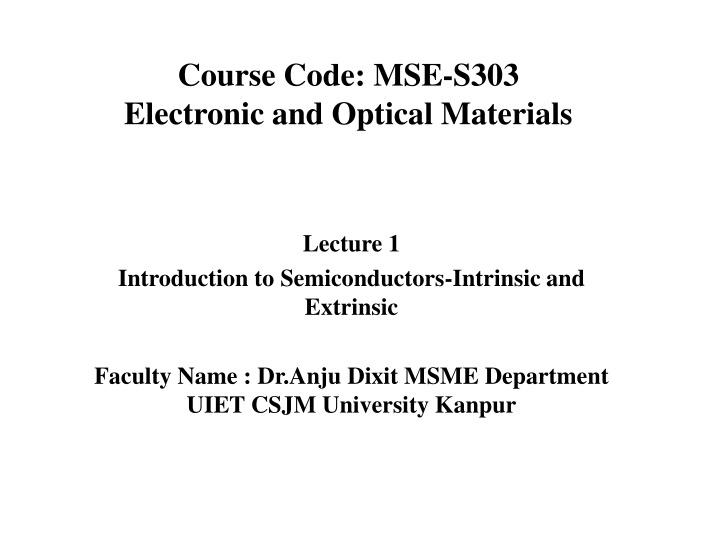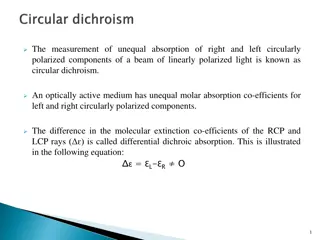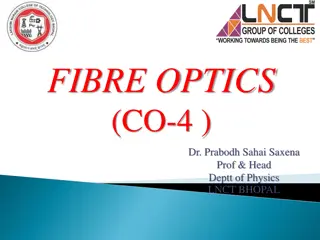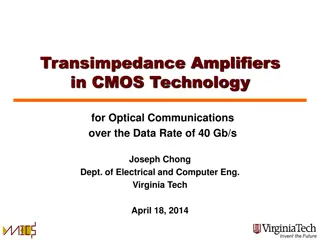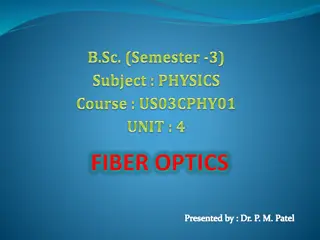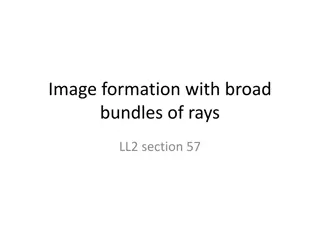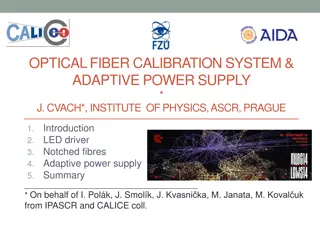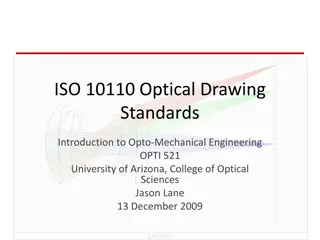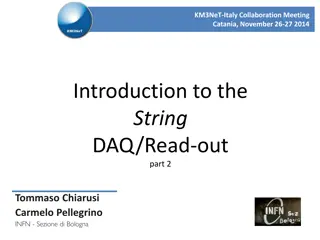Introduction to Electronic and Optical Materials
This course covers topics on semiconductors, conductivity, band structure, intrinsic and extrinsic semiconductors, band gap engineering, applications of semiconductors, and more. It explores electron dynamics, optical properties, and conductivities of materials in depth.
Download Presentation

Please find below an Image/Link to download the presentation.
The content on the website is provided AS IS for your information and personal use only. It may not be sold, licensed, or shared on other websites without obtaining consent from the author.If you encounter any issues during the download, it is possible that the publisher has removed the file from their server.
You are allowed to download the files provided on this website for personal or commercial use, subject to the condition that they are used lawfully. All files are the property of their respective owners.
The content on the website is provided AS IS for your information and personal use only. It may not be sold, licensed, or shared on other websites without obtaining consent from the author.
E N D
Presentation Transcript
Course Code: MSE-S303 Electronic and Optical Materials Lecture 1 Introduction to Semiconductors-Intrinsic and Extrinsic Faculty Name : Dr.Anju Dixit MSME Department UIET CSJM University Kanpur
Syllabus Electron dynamics and concept of holes, electron-hole recombination ,conductivity in relation to band structure, direct and indirect band gap, Degenerate and non-degenerate semiconductor, lntrinsic and extrinsic semiconductor, band gap engineering, applications of semiconductors, solid state LED s, organic semiconductors DC and AC conductivity of metals, Hall effect and Magneto resistance, Thermal conductivity and specific heat of material, thermo power of meals. Ionic conduction-review of defect equilibrium and diffusion mechanism, theory of ionic conduction, conduction in glasses, application in sensors and batteries, conducting polymers, piezoelectric materials, optical materials, , Laser and IR-detector, , light interaction with materials transparency, translucency, opacity, refraction and refractive index, reflection, absorption and transmission.
Introduction The branch of science dealing with passage of current in conductors - Electrical The branch of science dealing with passage of current in semiconductors Electronics The resistivity is an electrical property but the gap is an electronic property. Capacitance , resistance and inductance are electrical properties also. There is another thing that allows us to distinguish between them is that the electronic phenomena occurs at microscopic level while electric phenomena occurs at macroscopic level. Based on the working source (electrons or holes) Electrical- Here the flow phenomenon (current) associated with only "electrons flows". Electronics- But here the flow phenomenon (current) associated with both "electrons and holes flows".
Semiconductor Resistivity Chart Materials that permit flow of electrons are called conductors (e.g., gold, silver, copper, etc.). Materials that block flow of electrons are called insulators (e.g., rubber, glass, Teflon, mica, etc.). Materials whose conductivity falls between those of conductors and insulators are called semiconductors. Semiconductors are part-time conductors whose conductivity can be controlled.
Energy band As isolated atoms are brought together to form a solid, the electron wave functions begin to overlap. Various interactions occur, and, at the proper interatomic spacing for the crystal, the forces of attraction and repulsion find a balance. Due to Pauli exclusion principle, the discrete energy levels of individual atoms split into bands belonging to the pair instead of to individual atoms. In a solid, due to large number of atoms, the split energy levels form essentially continuous bands of energy. Interatomic Spacing Imaginary formation of a diamond crystal from isolated carbon atoms. Each atom has two 1s states, two 2s states, six 2p states, and higher states.
For N atoms, the numbers of states are 2N, 2N, and 6N of type 1s, 2s, and 2p respectively. With a reduction in the interatomic spacing, these energy levels split into bands, and the 2s and 2p bands merge into a single band having 8N available states. As the interatomic spacing approaches the equilibrium spacing of diamond crystal, this band splits into two bands separated by an energy gap , where no allowed energy states for electrons exist forbidden gap. The upper band (called the conduction band) and the lower band (called the valence band) contain 4N states each. The lower 1s band is filled with 2N electrons, however, the 4N electrons residing in the original n = 2 state will now occupy states either in the valence band or in the conduction band. At 0 K, the electrons will occupy the lowest energy states available to them thus, the 4N states in the valence band will be completely filled, and the 4N states in the conduction band will be completely empty.
Energy diagram The Energy diagram represents two energy bands, the valence band and the conduction band. The electrons in the valence band in the energy diagram represent the electrons which are in the valence band of the atom and they are still bonded to the parent atom. The electrons in the conduction band in the energy diagram represent atoms which take part in conduction. The energy gap between the valence and conduction band is called as the forbidden band or band gap. A conduction band is a delocalized band of energy levels in a crystalline solid that is partially filled with electrons. These electrons are highly mobile and are responsible for electrical conductivity The valence band is the band of electron orbitals that electrons can jump out of, moving into the conduction band when excited. The valence band is simply the outermost electron orbital of an atom of any specific material that electrons actually occupy. This is closely related to the idea of the valence electron. The energy difference between the highest occupied energy state of the valence band and the lowest unoccupied state of the conduction band is called the band gap and is indicative of the electrical conductivity of a material
Conduction Band Valence Band Energy band formed by a series of energy levels containing valence electrons Higher energy level band Partially filled by the electrons. Always filled with electrons Empty band of minimum energy. Band of maximum energy Electrons can gain energy from the external electric field. Electrons are not capable of gaining energy from the external electric field. The free-electron is able to move anywhere within the volume of the solid. No flow of current due to electrons present in this band. The highest energy level which can be occupied by an electron in the valence band at 0 K is called the Fermi level. Current flows due to such electrons.
Hole In semiconductors, electric current is carried by two types of charge carriers they are electrons and holes. The absence of electron in a particular place in an atom is called as hole. Hole is a electric charge carrier which has positive charge. The electric charge of hole is equal to electric charge of electron but have opposite polarity. When a small amount of external energy is applied, electrons in the valence band moves in to conduction band and leaves a vacancy in valence band. This vacancy is called as hole. then the
Electron Kinetic energy energy Increasing hole Ec Ev Hole Kinetic energy The minimum conduction electron energy is Ec . Any energy above Ec is the electron kinetic energy. A lower location in the energy diagram represents a higher hole energy. It requires energy to move a hole downward because that is equivalent to moving an electron upward. Ev is the minimum hole energy. We may think of holes as bubbles in liquid, floating up in the energy band. Similarly, one may think of electrons as water drops that tend to fall to the lowest energy states in the energy band.
Electron and hole current In conductors current is caused by only motion of electrons but in semiconductors current is caused by both electrons in conduction band and holes in valence band. Current that is caused by electron motion is called electron current and current that is caused by hole motion is called hole current. Electron is a negative charge carrier whereas hole is a positive charge carrier. At absolute zero temperature intrinsic semiconductor behaves as insulator. However, at room temperature the electrons present in the outermost orbit absorb thermal energy. When the outermost orbit electrons get enough energy then they will break bonding with the nucleus of atom and jumps in to conduction band. The electrons present in conduction band are not attached to the nucleus of an atom so they are free to move.
Electron and hole current When the valence electron moves from valence band to the conduction band a vacancy is created in the valence band where electron left. Such vacancy is called hole. The conduction band electrons are responsible for electrical conductivity. The measure of ability to conduct electric current is called as electrical conductivity. When the temperature is goes on increasing, the number of valence band electrons moving in to conduction band is also increases. This shows that electrical conductivity of the semiconductor increases with increase in temperature. i.e. a semiconductor has negative temperature co-efficient of resistance. The resistance of semiconductor decreases with increase in temperature.
Difference among Conductors , Semiconductors and Insulators
Parameter Conductor Semiconductor Insulator Forbidden energy gap Not exist Small (1 eV) Large (>5 eV) Medium (10-7to 10-13 mho/m) Very Low (10-3 mho/m) Almost negligible. Conductivity High (10-7 mho/m) Resistivity Low Moderate High Due to movement of free electrons. Due to movement of electrons and holes. Almost negligible but only due to free electrons. Flow of current Temperature coefficient of resistance Positive Negative Negative Charge carriers in conduction band Completely filled Partially filled Completely vacant Charge carriers in valence band Almost vacant Partially filled Completely filled Copper, Aluminium, graphite etc. Silicon, Germanium, arsenic etc. Paper, rubber, glass, plastic etc. Example Conducting wires, Transformers, in electrical cords etc. Diodes, transistors, optocouplers etc. Sports equipment, home appliances etc. Applications
Periodic Table of Semiconductors Elements Group 13 Elements Group 14 Elements Group 15 3-Electrons in Outer Shell (Positively Charged) 4-Electrons in Outer Shell (Neutrally Charged) 5-Electrons in Outer Shell (Negatively Charged) (5) (6) (15) Boron ( B ) Carbon ( C ) Phosphorus ( P ) (13) (14) (33) Aluminium (Al ) Silicon ( Si ) Arsenic (As ) (31) (32) (51) Gallium ( Ga ) Germanium ( Ge ) Antimony ( Sb )
A Silicon Atom Structure The diagram above shows the structure and lattice of a normal pure crystal of Silicon
Antimony Atom and Doping The diagram above shows the structure and lattice of the donor impurity atom Antimony
Boron Atom and Doping The diagram above shows the structure and lattice of the acceptor impurity atom Boron
Summary Formation of Energy Band was discussed . Difference among Metals, Semiconductors and Insulators were discussed. Difference between Intrinsic and extrinsic semiconductors was discussed.
